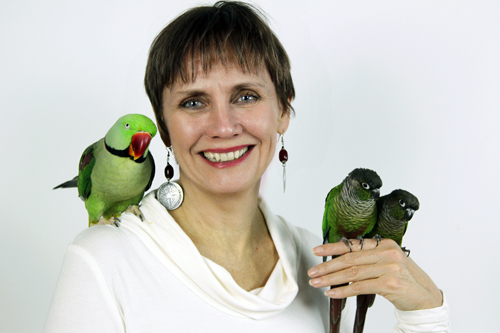
Prof. Dale Smith is one of the first to develop the tools needed to stop the spread of a deadly wasting disease that is killing pet birds across the globe.
With funding from Pet Trust, the pathobiologist and her colleagues recently created two diagnostic tests for proventricular dilatation disease (PDD) and are in the midst of developing a third.
“PDD is the most significant infectious disease among parrots,” said Smith. “There is no treatment, which makes it that much more important to prevent the disease from spreading. If we can identify infected birds and control the spread of PDD, then ideally we can eliminate it.”
PDD affects more than 50 species of birds, including macaws, cockatoos and cockatiels, parakeets and parrots. The Ontario Veterinary College (OVC) handles about 30 cases of PDD a year. Also known as the macaw wasting disease, PDD attacks the bird’s nervous system, particularly nerves affecting the gastrointestinal tract.
“The virus causes the nervous system to stop functioning properly,” said Smith. “When this affects the gastrointestinal tract, the birds literally waste away.”
Infected birds can suffer from weight loss, regurgitation, lethargy and diarrhea as well as neurological symptoms, including tremors, seizures and loss of balance. The virus is thought to spread through infected birds’ feces.
“Some birds become infected and die within months and some will carry the virus for years without showing symptoms,” she said.
PDD was first identified in the late 1970s in macaws imported from South America. Since then it has spread to virtually all species of parrots and around the world. Researchers spent decades trying to determine the cause of PDD and finally in 2008 were able to link the disease to a newly discovered avian bornavirus (ABV).
“For years it was a disease with no known cause, no treatment and no diagnostic tests,” said Smith. “As soon as scientists were able to connect it to a specific virus, we headed in the direction of developing a diagnostic test.”
Just two years later, Smith, along with U of G Animal Health Laboratory (AHL) diagnosticians Davore Ojkic and Josepha Delay and graduate students Raj Raghav and Pauline Delnatte, developed two diagnostic tests to identify the presence of ABV.
They designed a polymerase chain reaction test (PCR) to look for segments of the virus’s genetic material in the feces and oral cavity swabs of infected live birds as well as in tissues from birds that had died with the disease. They also developed an immunohistochemical test, which detects ABV viral antigens in the tissue.
The PCR test is currently available through the AHL to help veterinarians across Canada identify cases of PDD. Smith even used the tests recently to identify a new genotype of ABV in Canada geese and trumpeter swans.
“These wild waterfowl were showing signs similar to PDD so we thought we would try our new tests and see whether we could find a similar virus,” she said. “It allowed us to identify a whole new spectrum of disease in a different group of avian species.”
Although Smith’s tests are used to identify PDD in birds that have died, they can’t be used to accurately diagnose live birds with the disease. Infected birds irregularly shed the virus in their feces so it can’t always be picked up by the PCR test, and collecting a tissue sample from a live bird is risky.
“Conducting a biopsy to identify PDD in a bird is much more dangerous than conducting a simple skin biopsy on a dog or a cat,” said Smith. “The tissue samples needed to detect the virus must have nerves in them so it’s an invasive procedure to do on live birds.”
She is currently working on a test that can detect antibodies to the virus in the bird’s blood so all it would require is a simple blood test.
“Having antibodies to the virus doesn’t necessarily mean the bird is currently sick with the disease but that it has been in close contact with the virus,” said Smith, who is working on the new test with pathobiology professor Eva Nagy, OVC clinician Michael Taylor and Delnatte.
The researchers are in the process of validating the test and will have to make sure it is applicable to all types of parrots. Unlike breeds of dogs and cats, which are all members of one species, there are a number of species of parrots, said Smith.
“An African grey parrot, a macaw, a cockatoo and a cockatiel are all different from each other so we need to develop a test that is independent of species.”
The test would be beneficial for zoos and aviaries bringing in new birds as well as for pet owners with multiple parrots.
“Since some birds don’t show signs of the disease but can still be carriers, you would want to test a new bird before having it share a space with other birds,” said Smith. “But beyond looking after individual birds, having a diagnostic test for live birds is important for the whole parrot world to decrease the spread of the disease. PDD has not yet been diagnosed in wild parrots, and we want to keep it that way.”